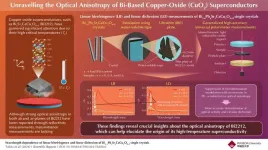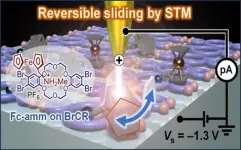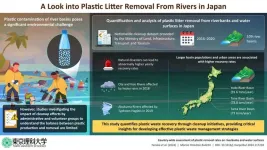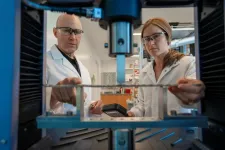What brings richness to sparkling wines?
2024-12-12
(Press-News.org) “Rich” and “full-bodied” are terms that people often use to describe the taste of wine. They are also the properties that kokumi compounds bring to foods like mature Gouda cheese, though scientists haven’t widely explored them in wines. In ACS’ Journal of Agricultural and Food Chemistry, researchers now connect the dots and report 11 probable kokumi compounds in sparkling wines.
Kokumi is often confused with the better-known term umami. Umami is a savory, meaty flavor and is one of the basic five tastes, along with sweet, sour, bitter and salty. However, kokumi is not a taste or flavor on its own — it’s a combination of compounds that work together to enhance flavors and provide richness. Previously, researchers have shown that glutathione and several other short peptides impart a kokumi sensation in foods and drinks such as garlic, onions, beans, cheese and beer. But these compounds have not been investigated in wine. So, Fulvio Mattivi, Luca Dellafiora and colleagues set out to do so.
The researchers found that five vintages of Italian Trentodoc sparkling wine contain a mixture of 50 short peptides that could possibly be the source of the wine’s kokumi properties. Next, they discovered that 11 of the 50 kokumi candidates interacted with computer-simulated human calcium-sensing receptors in a way that’s similar to other known kokumi compounds. When team members surveyed another 34 Trentodoc wines, they verified that these 11 compounds were indeed representative of this style of Italian sparkling wine. Finally, wine-tasting experts confirmed Gly-Val — one of the 11 candidates — as a probable kokumi compound because it enhanced flavor when added to wine samples.
The team says further studies are needed, but this report represents the first step toward describing the molecular basis of the kokumi sensation in wines. “In light of these results, it will be necessary to further investigate the role of winemaking technology and yeasts in releasing kokumi oligopeptides derived from the grape proteins, bringing further richness to classic sparkling wines, and extending the investigation to other wine styles as well,” says Mattivi.
The authors acknowledge funding from the Autonomous Province of Trento.
###
The American Chemical Society (ACS) is a nonprofit organization chartered by the U.S. Congress. ACS’ mission is to advance the broader chemistry enterprise and its practitioners for the benefit of Earth and all its people. The Society is a global leader in promoting excellence in science education and providing access to chemistry-related information and research through its multiple research solutions, peer-reviewed journals, scientific conferences, e-books and weekly news periodical Chemical & Engineering News. ACS journals are among the most cited, most trusted and most read within the scientific literature; however, ACS itself does not conduct chemical research. As a leader in scientific information solutions, its CAS division partners with global innovators to accelerate breakthroughs by curating, connecting and analyzing the world’s scientific knowledge. ACS’ main offices are in Washington, D.C., and Columbus, Ohio.
Registered journalists can subscribe to the ACS journalist news portal on EurekAlert! to access embargoed and public science press releases. For media inquiries, contact newsroom@acs.org.
Note: ACS does not conduct research but publishes and publicizes peer-reviewed scientific studies.
Follow us: X, formerly Twitter | Facebook | LinkedIn | Instagram
END
ELSE PRESS RELEASES FROM THIS DATE:
2024-12-12
Superconductors are materials which conduct electricity without any resistance when cooled down below a critical temperature. These materials have transformative applications in various fields, including electric motors, generators, high-speed maglev trains, and magnetic resonance imaging. Among these materials, CuO2 superconductors like Bi2212 stand out due to their high critical temperatures that surpass the Bardeen–Cooper–Schrieffer limit, a theoretical maximum temperature limit for superconductivity. However, ...
2024-12-12
Artificial molecular machines, nanoscale machines consisting of a few molecules, offer the potential to transform fields involving catalysts, molecular electronics, medicines, and quantum materials. These machines operate by converting external stimuli, like electrical signals, into mechanical motion at the molecular level. Ferrocene, a special drum-shaped molecule composed of an iron (Fe) atom sandwiched between two five-membered carbon rings, is a promising foundational molecule for molecular machinery. Its discovery earned the Nobel Prize in Chemistry in 1973, and it has since ...
2024-12-12
Plastic pollution is an ever-growing problem in today’s world, as most societies have become overly dependent on plastics for packaging, medical supplies, and general goods. Plastic litter accumulation in the ocean, either through deliberate dumping or by being transported from a river, poses significant environmental challenges. Additionally, this plastic eventually degrades into small fragments called microplastics, which then impact diverse marine and land ecosystems by working their way up the food chain and into most living organisms. Though their negative effects on cell health are still under study, many nations have taken a cautionary stance, ...
2024-12-12
EUGENE, Ore. — Dec. 12, 2024 — Tiny implantable sensors are helping University of Oregon researchers optimize the process of recovery from severe bone injuries.
Scientists at the UO’s Phil and Penny Knight Campus for Accelerating Scientific Impact have developed miniature implantable sensors that transmit real-time data about what’s happening at an injury site. In a new study, they use the technology to show that a resistance-training rehabilitation program can significantly improve femur injuries in rats ...
2024-12-12
Fusion energy research is being pursued around the world as a means of solving energy problems. Magnetic confinement fusion reactors aim to extract fusion energy by confining extremely hot plasma in strong magnetic fields. Its development is a comprehensive engineering project involving many advanced technologies, such as superconducting magnets, reduced-activation materials, and beam and wave heating devices. In addition, predicting and controlling the confined plasma, in which numerous charged particles and electromagnetic fields interact in complex ...
2024-12-12
A new study led by investigators from Mass General Brigham has identified a unique brain network that links varied patterns of brain atrophy, or shrinkage, associated with schizophrenia. By combining neuroimaging data from multiple studies involving more than 8,000 participants, the research team found a specific connectivity pattern of atrophy that was present across different stages and symptoms of schizophrenia — and distinct from brain networks associated with other psychiatric disorders. The findings will help to guide a clinical trial that will start recruiting patients soon and will ...
2024-12-12
Research has long shown that humans are susceptible to “social identity bias”—favoring their group, whether that be a political party, a religion, or an ethnicity, and disparaging “outgroups.” A new study by a team of scientists finds that AI systems are also prone to the same type of biases, revealing fundamental group prejudices that reach beyond those tied to gender, race, or religion.
“Artificial Intelligence systems like ChatGPT can develop ‘us versus them’ biases similar to humans—showing favoritism toward their perceived ‘ingroup’ while expressing ...
2024-12-12
It has been known for nearly 20 years that slow, synchronous electrical waves in the brain during deep sleep support the formation of memories. Why that is was previously unknown. Now, writing in the journal Nature Communications, a team of researchers from Charité – Universitätsmedizin Berlin posits an explanation. According to the study, the slow waves make the neocortex, the location of long-term memory, especially receptive to information. The findings could help to optimize the treatment approaches that are intended to support memory formation from outside.
How do permanent memories form? Experts believe that while we sleep, our brains replay the events of ...
2024-12-12
Railways, the most climate-friendly mode of transport bar long-distance buses, are bound to play an important role in the fight for net zero. The total emissions of railway travel are currently 31 grams of CO2 equivalents (CO2e) per passenger kilometer, half the amount as for the most economical electrical vehicles.
But the carbon emissions of railway traffic can be further reduced, shows a new study in Frontiers in Sustainability by authors in Finland. This is because typical construction materials such as steel and concrete are energetically costly to produce, transport, handle, and maintain. Even on the ...
2024-12-12
Food poisoning is a common, yet unpleasant, illness caused by eating contaminated items. It is sometimes caused by Clostridium perfringens, a pathogen widely found in soil and the intestinal tracts of animals.
The pathogen multiplies in environments with little oxygen, for example, curry stored in a pot. After ingestion of the pathogen, they form spores in the small intestinal tracts. The toxins produced during spore formation cause diarrhea and abdominal pain, but the underlying mechanism of spore formation has not been fully understood.
Associate Professor Mayo Yasugi’s team at Osaka Metropolitan University’s ...
LAST 30 PRESS RELEASES:
[Press-News.org] What brings richness to sparkling wines?






